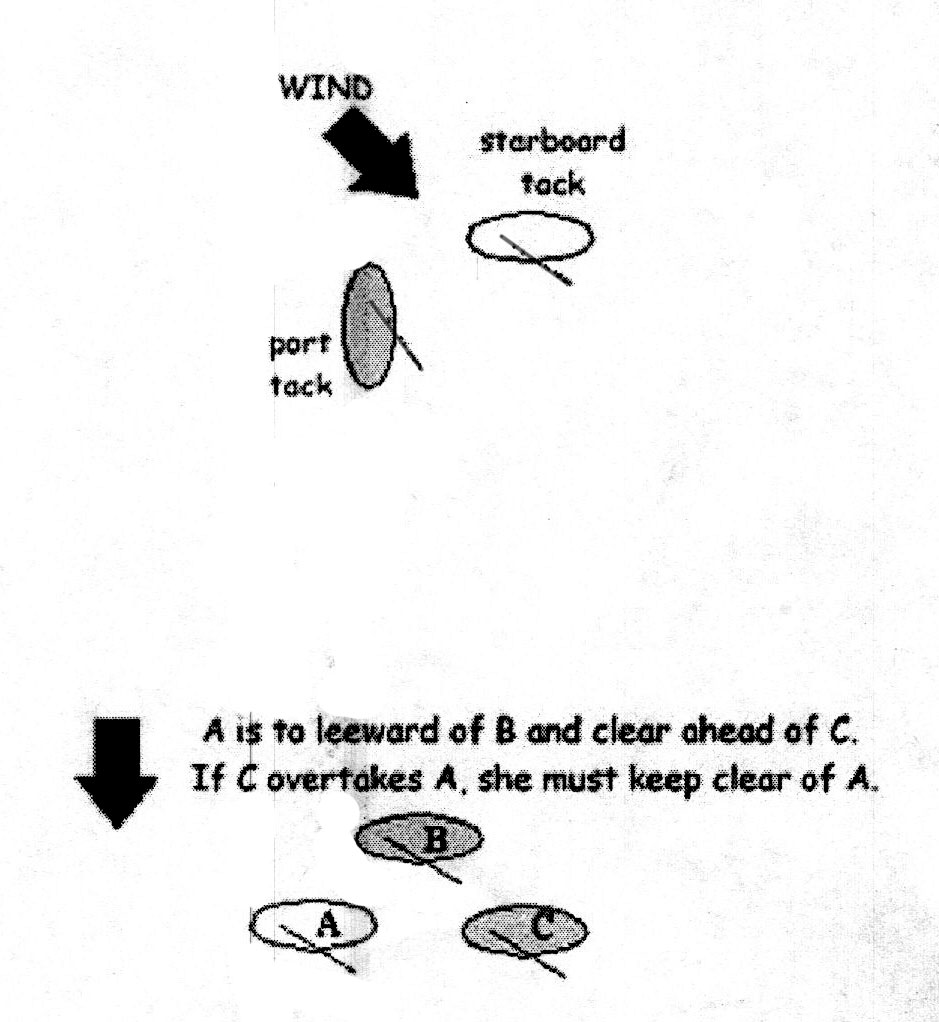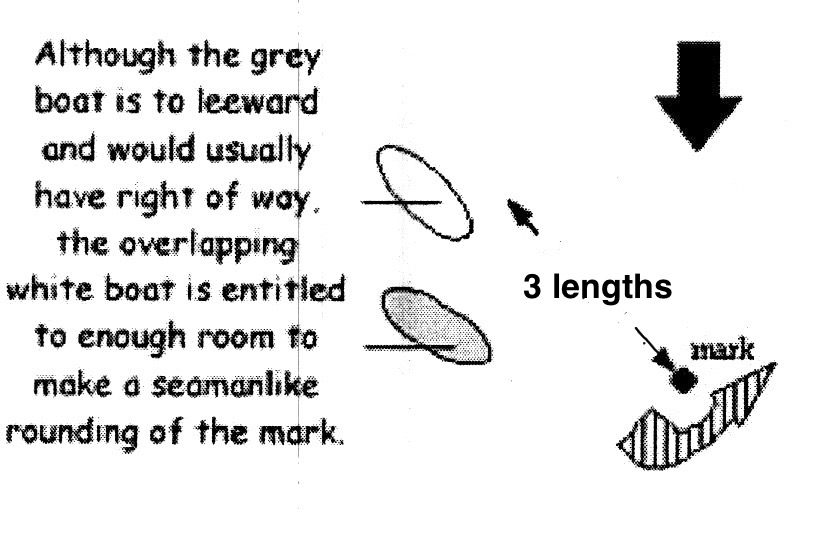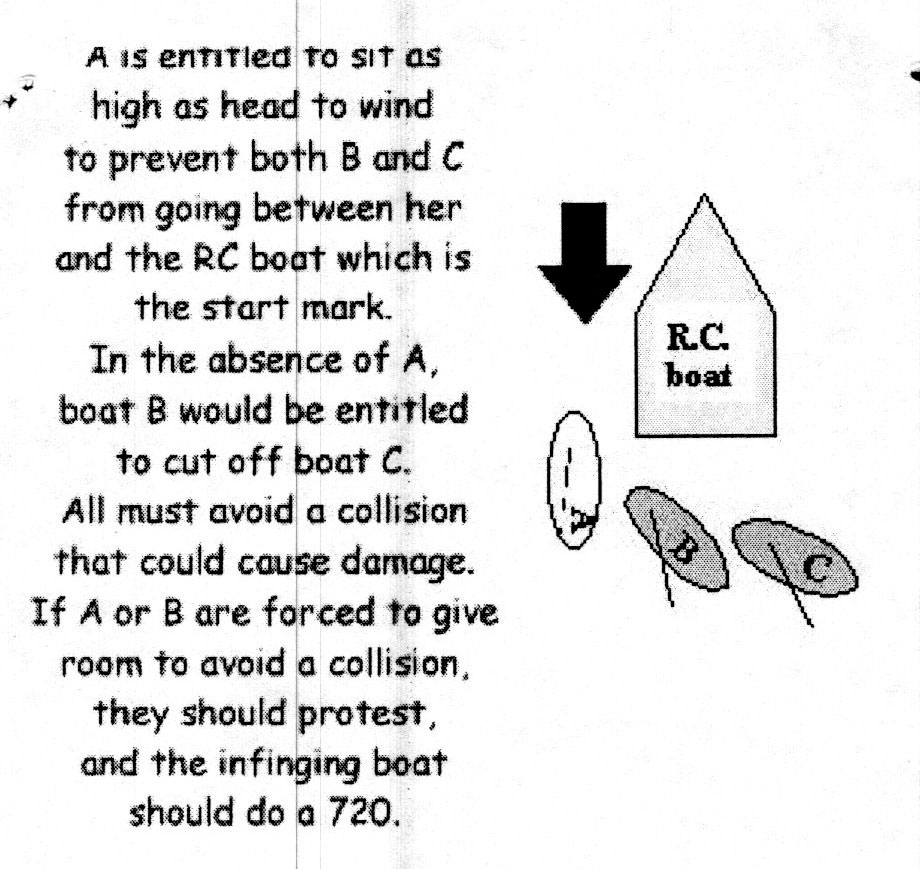Below, you will find the Right of Way Rules for racing in a very brief and simplified form. They are intended as a guide for new racers until they can become familiar with the Racing Rules of Sailing. These rutes are not intended as a substitute tor the official rules.
1. PORT/STARBOARD: When boats on opposite tacks meet, i.e. their booms are on opposite sides of the boat, the port tack boat must keep clear. The
starboard skipper should assert his right-of-way by calling “starboard.”
The tack is named for the windward side of the boat. ie. the side opposite the boom. If, as you face
forward, the right side of the boat is windward, you are on starboard tack Otherwise you are on port. (see diagram – right-of-way boat is labeled
starboard.)

2. WINDWARD/LEEWARD: When boats are on the same tack, i.e. booms on the same side, two rules apply:
- Windward boat keep clear
- Overtaking boat keep clear
This rule also covers upwind downwind boats meeting.
3. CHANGING TACK: While you are tacking, you must keep clear of other boats that are not doing so. If you acquire the right-of-way over a boat nearby with a tack or gibe, you must give that boat reasonable
room and time to react. You cannot tack to force a nearby boat to tack because you have no rights until you have completed the tack.
4. AVOIDING COLLISIONS: Even when you have the right of way you must try hard to avoid any collision. In any case, hitting another boat is slow!!
5. BUOY ROOM: When you round or pass a mark other than a starting mark, you must give room to round that mark to any boat that has an inside overlap on you as you get near (three boat lengths from) the mark under the Rules, you should also avoid tacking within two boat lengths of a windward mark if any other boats are near you.

6. BARGING: The “buoy room” rule does not apply at the start line. Do not barge there by trying to squeeze between a boat to leeward of you and a
mark. Note that a committee boat that marks an end of the start or finish line is considered a mark.
A luffing boat may not pass beyond head to wind if there is another boat there.

7. OVER EARLY: If any part of your boat or equipment is across the start line when the start signal is made, you must re-start. While returning to the start line to re-start, you must keep clear of any boats that are not
returning. Often the best approach in a crowd is to let your sails luff or even back wind them and slow down until you can return to the line without fouling anyone.
8. DEFENDING AGAINST OVERTAKING BOATS: If a boat tries to pass you to windward, you are entitled to defend your wind by luffing up but must do so in such a way as to give the windward boat room to keep clear (see also item #4) A luffing boat may not pass beyond head to wind while the other boat is there.
If a near-by boat tries to pass you to leeward on a reach or run, you are not allowed to make life even tougher for that boat by sailing below the course to the next mark.
9. TOUCHING A MARK: If you touch a mark, you may-continue to race only after getting out of the way of other boats and sailing a complete circle.
10. RULE INFRINGEMENT: You are officially racing and therefore bound by the racing rules from your Prep Signal (usually the 5-minute ‘gun’) until you have cleared the finish line.
If you break a rule, the racing rules and good sportsmanship require that you do a 360° turn. As in item #9, you may continue to race only after immediately getting out of the way of other boats and, in this case,
sailing two consecutive complete circles.
If there is a collision, the rules (usually) require that there be a protest or a 360. You may have a live and let live attitude and minor fouls are sometimes forgiven. For instance, let’s say a starboard boat has to bear off a couple of inches to avoid a port tack boat crossing in front Halfway up the first beat, that may be no big deal and require nothing more than: “You owe us one!”
Near the mark or tl1e finish, however, such a foul looms much larger and you may well wish to protest Or, if I am the one who committed the foul, I should definitely do a 360 without even being asked to!
If you are fouled and you intend to protest, you must do two things immediately
- yell (tr1e actual word) “Protest!”
- display a red protest flag if you have one. NOTE: As of 2001, a protest flag is no longer required on boats that are less than 16 meters long!
If the offending party does a 360, you can forget the matter. Otherwise, you inform the Race Committee, at the finish line, whom you are protesting When you reach sr1ore, you fill in a protest form and attend a hearing that will decide the protest.
Webmaster Note: These rules and diagrams were copied from documents we had in the clubhouse (with slight modification), that bore no markings as to origin or any copyright. GYC makes no claims to either, and if you would like to make a claim, please contact the club using the contact form on this site.
